Damascus Knife Manufacturers
67 layers of damascus steel, selected 9cr18MoV steel core, with good durability, making the knife sharp and durable, reducing edge curling and chipping.
Adhere to manual fine grinding to keep the knife cutting feel and take into account the edge strength.
Exquisite Damascus pattern in black and white, clear lines and light and dark changes.
Home > Damascus Knives
What Is A Damascus Knife
1. Definition of Damascus Knife:
In a broad sense, Damascus Knife: any steel knife with patterns on the surface.
In a narrow sense, Damascus Knife: specifically refers to the patterned steel knives made by the ancient Persian tribes using Indian Wootz steel as raw material.
2. Classification of Damascus Knife:
1. Ancient Wootz Steel Damascus Knife.
The smelters in ancient India put iron ore and some special plants and minerals in a sealed crucible for smelting, and slowly cooled them. The cast steel ingots contained a large amount of impurities, including some extremely hard carbides. This steel ingot was trafficked to Central Asia, and Persian craftsmen used it and wrought iron to forge swords. Legend has it that the carbides in the steel ingots are evenly distributed on the knife body after forging, forming special patterns and microscopic serrations on the edge of the blade. There is no written record of the entire smelting and forging process of the Wootz Steel Damascus Knife, which is entirely based on speculation by later generations, so there are many controversies. What is certain is that India once produced high-quality iron ore, and Persian craftsmen used it to create world-famous swords. There are very few existing Wootz steel knives, most of which are kept in museums and their prices are difficult to estimate.
2. Folding forged Damascus knife (referred to as hand-forged Damascus knife).
It uses several steels of different hardness, heated to a soft but not melting temperature, forged, folded, and twisted. In this process, the steel is stacked and welded to form a multi-layer composite structure, and the sword made is both hard and soft, and there are winding patterns on the surface.
3. Welded Damascus knife.
The blade is forged by folding, and the handle is connected by welding.
4. Modern Damascus knife
The knife with Damascus decorative effect is forged by folding, but the performance of these knives is not very good. There are also counterfeit products, which are purely camouflaged patterns by etching or other processes.
5. Swedish powder Damascus knife
Powder Damascus steel is also a composite steel composed of more than two kinds of steel. The layering is completed in an oxygen-free environment at the beginning of powder production, and the interlayer welding is consolidated by high temperature and high pressure process in an oxygen-free environment.
The obtained multi-layer steel plate, after die forging and grinding, can obtain various classic or cutting-edge patterns. Unlike the patterns obtained by forging and welding, the patterns of Swedish powder Damascus are transparent, and because powder steel itself is a high-hardness material, core material is generally no longer required.
6. American Thomas Damascus knife.
The patterned steel knife is made of stainless steel or Swedish powder steel and hand-forged Damascus steel as raw materials through modern mechanical forging, grinding and other processes. It pursues changes in patterns and designs, has good rust resistance, and is expensive.
7. Laser engraved Damascus knife.
Using laser to engrave patterns on ordinary steel, it is often pretending to be a hand-forged Damascus knife.
8. Strong acid corrosion Damascus knife.
Etching technology is used to etch patterns on ordinary steel. Generally, the appearance is rough, like a burn patient.
9. Surface coating (electroplating) Damascus knife.
10. Modern Wootz steel Damascus knife.
A patterned steel knife that imitates Wootz steel has only appeared in recent years.
Changwen Damascus Knives
Changwen Damascus knives are made of 9Cr18MoV, 10Cr15CoMoV or AUS10 steel with a carbon content of 0.9-1.0%. After heat treatment, the Rockwell hardness is generally around 58-60HRC. It has a higher hardness, which can make the sharpness last longer. Changwen is one of the leading kitchen knife wholesale suppliers. With exquisite craftsmanship and technological innovation, it stands out in the overseas market. Its products are sold well in 41 countries including Europe, America, Japan, South Korea and Southeast Asia.
Damascus Knives
67 Layers Damascus Steel
10Cr15CoMoV Steel
The 10Cr15CoMoV steel core is made of 67 layers of steel composite folding and forging. Non-laser patterned real Damascus steel natural pattern.
Resin plus burl wood, made by special process. Comfortable grip, ergonomic mechanics, strong and durable, not easy to break, easy to use.

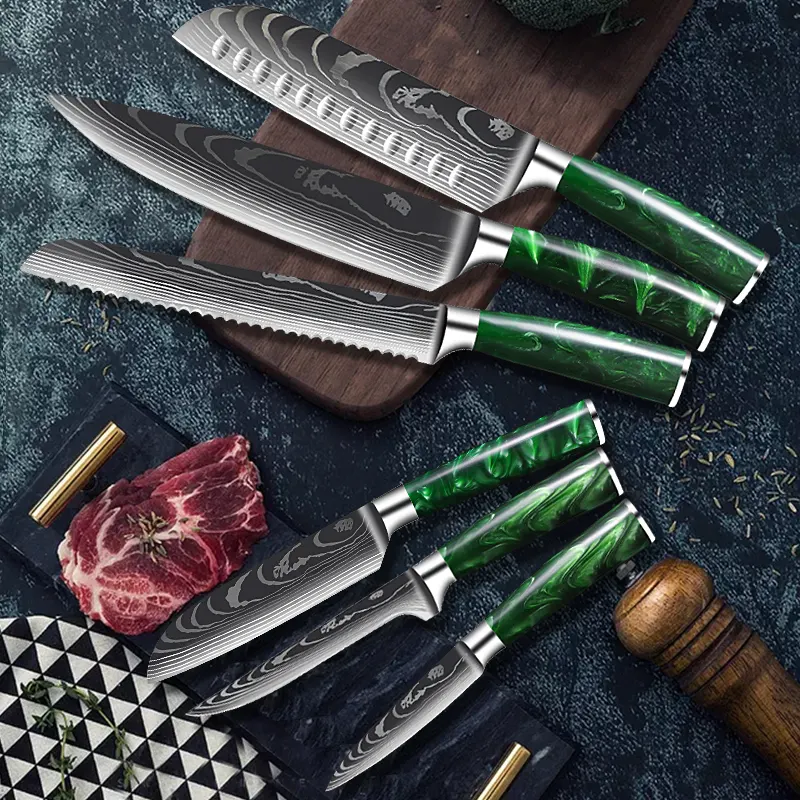
Damascus Knives
67 Layers Damascus Steel
AUS10 Steel
C: Increase steel strength, Mo: Prevent steel from becoming brittle Cr: Increase steel wear resistance, V: Increase steel toughness
Main components of AUS-10 steel: C: 0.95-1.1%/Mo: 0.1-0.3%/Cr: 13-14.5%/V: 0.1-0.25%.
The handle is designed in accordance with ergonomics, allowing every user to feel the light blade, comfortable grip and unparalleled sharpness the moment they hold the kitchen knife.


Customize Your Damascus Kitchen Knife Today
The quality of damascus kitchen knife is mainly determined by five aspects: hardness, toughness, wear resistance, corrosion resistance, and sharpness retention. How to customize a high-quality kitchen knife requires strict selection of all aspects from materials to craftsmanship and skilled craftsmanship.
Changwen professional damascus knife Manufacturers provide you with customized Damascus kitchen knife sets, or custom one of the following styles: cleaver knife, chooper knife, gyuto knife, chef knife, sujihiki knife, slicer knife, bread knife, kiritsuke knife, small cleaver knife, santoku knife, utility knife, or paring knife.
Damascus Steel Classification
Damascus steel, a type of steel, first appeared in the Mesopotamian Basin and the northern part of the Ganges Plain. The earliest processing method that can be verified is the Indian crucible processing method that originated in northern India. It is also called crystal pattern steel and cast pattern steel. It is a perfect combination of ancient powder metallurgy and forging technology. It is called WOOTZ in most parts of Britain, the United States and Europe, and FULAT in its place of origin, India, Pakistan and Persia. It is called BULAT in the Caucasus region of Russia. At that time, India had the best iron ore in the world, and this iron ore was used in their crucibles. Good ore creates Damascus steel, and India is famous for Damascus steel.
When people talk about Damascus knives now, they usually refer to all knives with patterns on the surface. This is a broad term, and we must distinguish it from the original Damascus knives. The patterns on modern Damascus knives are made of layers of steel with different compositions. The steel we commonly use includes the following parts.
| American Steel | Japanese Steel | Swedish Steel | Austrian Steel | German Steel |
| S35VN | ZDP-189 | RWL34 | M390 | Z-Tuff PM |
| BG42 | HAP-40 | 12C27N | Zwear PM | |
| CPM S30V | SG2 | 14C28N | Vanadis 8 | |
| CPM S9OV | MD606 | 1.4116 | ||
| CPM S100V | MD305 | |||
| CPM S110V | SKD11 | |||
| PM23 | VG-10 | |||
| CPM M4 | AUS-10 | |||
| W-2 | AUS-8 | |||
| D2 | 440A | |||
| D2 | 440B | |||
| D2 | 440C |
The quality of a knife is not as simple as choosing the right steel. The best balance is achieved between strength, hardness and toughness. Some blades are made to be extremely strong, but if you use it to pierce a very hard surface, it will break or shatter. On the other hand, a knife can be very tough and bend but its edge is not hard enough.
Changwen uses stainless steel with its own special formula as the raw material for the knife body. The characteristic of this new material is that it can achieve the best balance between the ratio of carbon and chromium. After multi-layer forging, the sharpness, hardness and corrosion resistance of the kitchen knife are more superior, and the quality and service life are improved.
Damascus Knife Pattern
In addition to its excellent performance, another important point of Damascus knife is that it has beautiful texture. Every Damascus knife has a delicate and exquisite texture, which makes it shine among many knives. If you want to customize your Damascus knife, we provide a rich selection of textures.
Among them are the following patterns:
Rose pattern
Taishan pattern
Quick sand pattern
Raindrop pattern
Ladder pattern
Wave pattern
Fishbone pattern
Auspicious cloud pattern
Peacock pattern
Wing pattern
Bronze horse pattern
Wave pattern
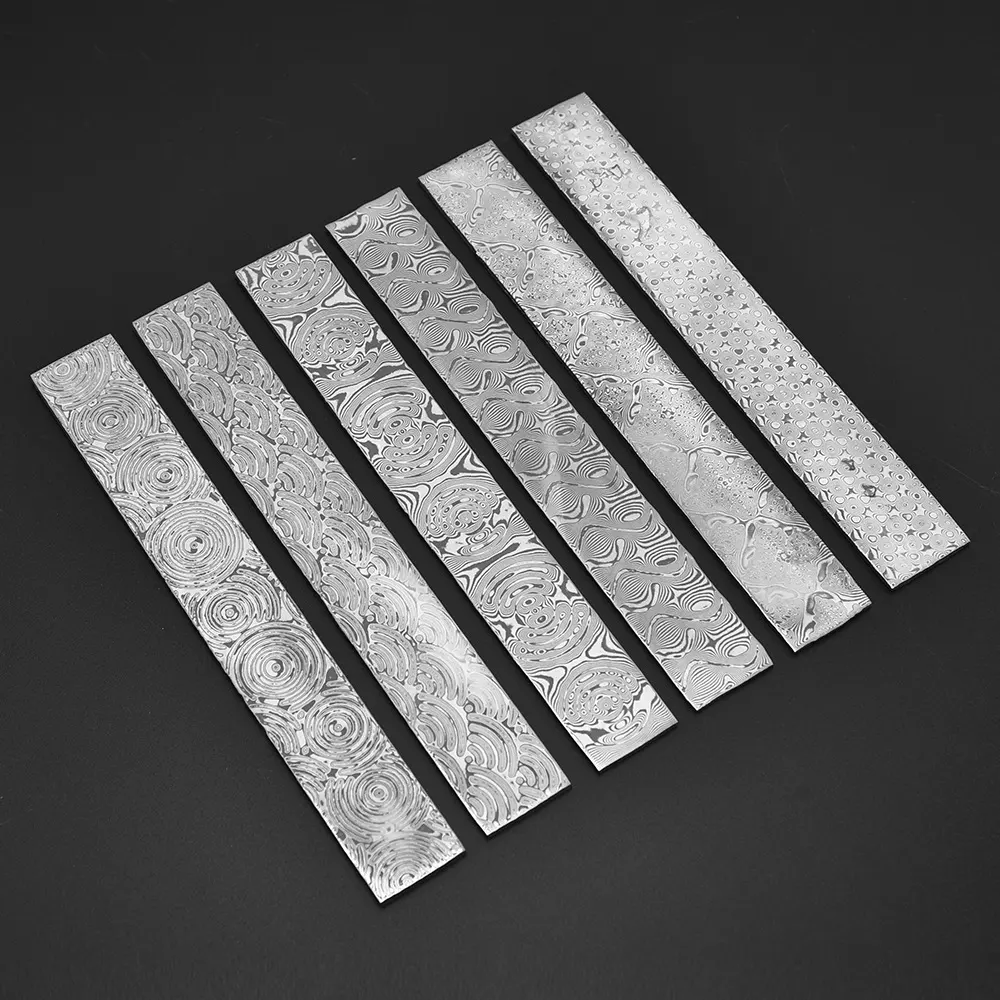
Handle Material And Knife Tang Structures Selection
This is our commonly used handle structure and style. Other handle structures and styles can be customized according to customer needs.
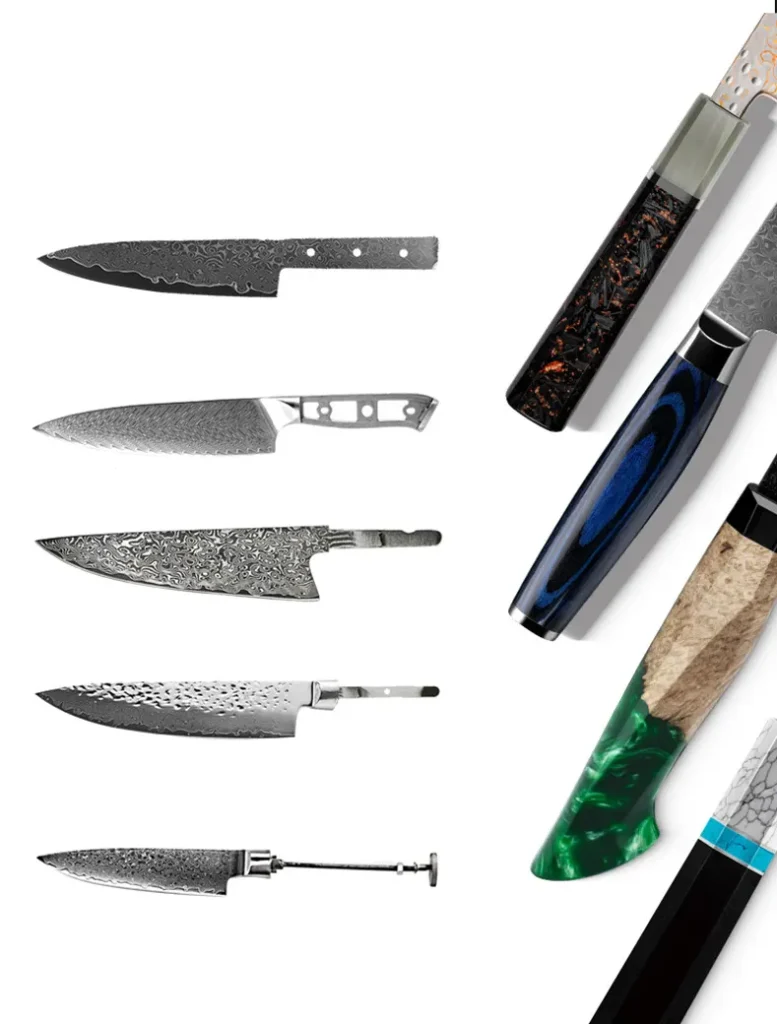
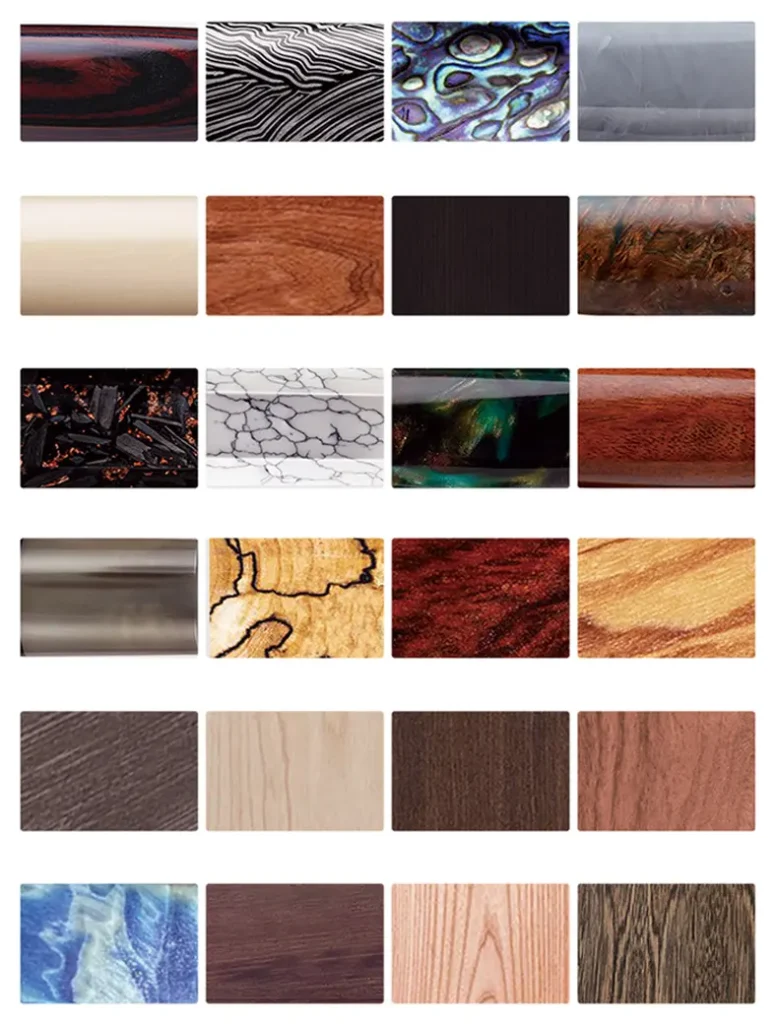
How Damascus Steel Knife Manufactured
The production of Damascus knives is a complex and time-consuming process. Damascus knives use folding forging technology, from design, material selection, forging, molding, grinding, polishing, a whole set of processes, very time-consuming and requires the knife maker’s exquisite craftsmanship.
After years of development, Changwen Damascus knives have mastered the entire set of craftsmanship. Each knife is carefully made through dozens of processes to make you a beautiful and high-quality Damascus knife.

Steel Stacking
Several types of steel with different hardness are stacked together, with a thickness of about 50-80 cm
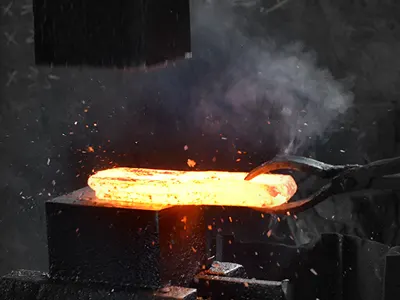
Forging
The pattern of the Damascus knife is formed naturally during the repeated firing and forging process.
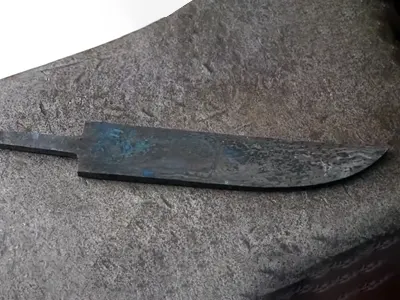
Forming
After the knife blank is forged, it is repeatedly hammered out to create the knife outline, and then further polished with a grinding wheel.
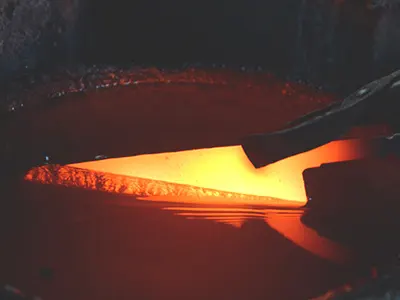
Quenching
Heat the knife to a certain temperature and immediately put it into oil or mud water containing minerals to cool it down. The main function of this process is to increase the hardness of the knife.
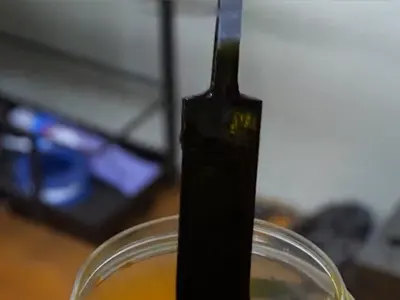
Pickling
After the quenched knife is initially polished, wipe or soak it with a weak acid, which will make the pattern of the Damascus knife more clearly visible.
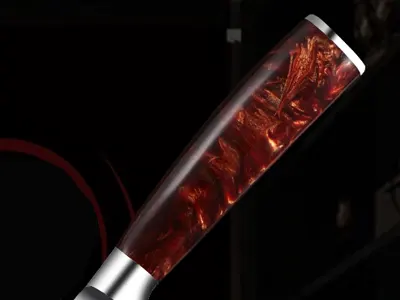
Decoration
Choose precious wood or resin to make the handle, polish it into a designed shape, and make it comfortable to hold.
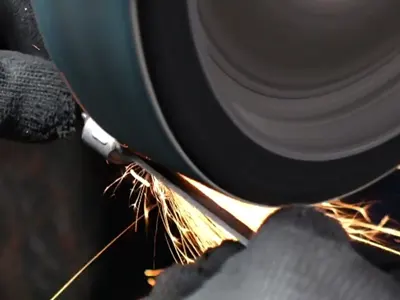
Grinding And Polishing
After the knife blank is forged, it is repeatedly hammered out to create the knife outline, and then further polished with a grinding wheel.
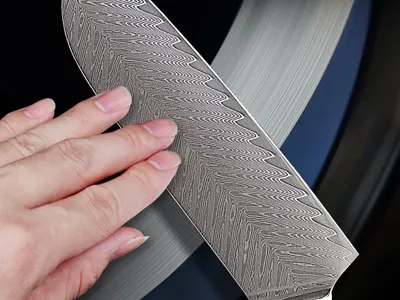
Sharpening And Quality Inspection Packaging
It uses 3000 mesh resin grinding wheel and 12°-15° water-grinding process on each side to increase the sharpness.Finally, the product is straightened manually, tested for hardness and toughness, and then packaged and shipped.
What Is The Difficulty In Making A Damascus Knife?
1. Careful selection of raw materials: Careful selection and strict proportioning
The raw materials for making Damascus knives are mainly iron and carbon. High-quality iron ore is repeatedly melted and purified to obtain iron with high purity. In order to increase the hardness of the knife and maintain its sharpness, an appropriate amount of carbon is usually added to the iron. Pure iron and carbon are mixed in a certain proportion. This process requires strict control of the ratio of iron and carbon to ensure the quality of the knife.
2. Heating and forging: hammering and gradually forming
Put the raw material block in a high-temperature furnace and heat it to make it soft and easy to forge. Then, through the folding forging process, steel with different carbon contents are stacked and repeatedly forged to form an alloy steel with complex microstructure and high strength. After forging, damascus steel knife blanks are formed by cutting and simple grinding. Damascus knives with high carbon content will have darker colors, while those with low carbon content will have brighter colors, so different textures such as waves, kinks, and annual rings will be formed, which will be more obvious after polishing and pickling.
3. Quenching: the core of the craft, determining the quality of the knife
After the knife blank is heated, it is quickly placed in cold water or oil for quenching. The quenching process can affect the hardness and toughness of the knife and is a key step in forging a Damascus knife. Only after proper quenching can the knife have excellent cutting power and durability.
4. Tempering: Adjust hardness and improve toughness
The quenched knife needs to be tempered to adjust the hardness and toughness of the knife. During the tempering process, the knife is heated to a certain temperature again and then slowly cooled. The purpose of tempering is to eliminate the internal stress in the knife and improve its toughness.
5. Grinding and polishing: keep improving and pursue perfection
After the above steps, the basic shape and performance of the Damascus knife have been formed. Next, the craftsmen began to grind and polish the knife. A top-level Damascus knife must take into account functionality, beauty and cutting ability, all three of which are indispensable. Beauty and cutting ability are the core content of grinding.
The first stage of grinding is to modify and shape, and its main purpose is to organize the shape and grind out the initial form of the work. The number of steps in this stage varies depending on the object. For example, there is a big difference between re-grinding a newly forged knife and a finished knife. For a newly made knife, there is no need to remove the surface rust and the rust spots that may penetrate into the blade, but some forging defects, such as forging marks or uneven pick lines, need to be corrected, which requires the use of multiple tools and processes. There may be other problems in repairing old knives, such as side bending, which cannot be returned to the furnace or cold forged, otherwise it will seriously damage the blade and even change the crystal structure, so repairing the knife is a very technical job.
After the general grinding is completed, it is time to enter the second stage of fine grinding. The knife grinder will use a small grinding stone for grinding. Generally, the grinding parts at this time are basically the two sides of the “blade pattern” and the polishing of the blade. Fine grinding requires great care and concentration, on the one hand to avoid cutting yourself, and on the other hand to prevent the blade from causing irreparable damage due to carelessness.
The third stage is to grind the edge and edge line, which is usually regarded as the most artistic and mysterious part of the entire grinding process. Every senior knife sharpener has his own unique insights, special habits and skills in terms of edge and edge line.
6. Assembly and packaging: perfect presentation, treasured products
After fine grinding and polishing, the craftsman installs the exquisite handle and then packages it. The final product is not only a weapon, but also a work of art, worthy of collection and inheritance.
Changwen Damascus Knife, in-depth research on each knife-making process, forging, quenching, grinding, sharpening, handle installation, these major processes can be decomposed into more than 20 small processes, the difficulties of each process have been overcome by us one by one, and high-quality Damascus knives have been successfully produced.
Damascus Steel Knife FAQ
After each use of a Damascus knife, wipe the blade and handle with a soft cloth to remove dirt and moisture. If there is grease or acid on the blade, gently wipe it with a neutral detergent and then wipe it dry with a dry cloth. Avoid wiping the blade with hard objects or abrasives to avoid damaging the pattern and sharpness.
The blade of a Damascus knife gradually becomes dull during use. In this case, use a 400-800 mesh grindstone to sharpen the blade again.
If you want to polish a Damascus knife, you can use 1000-2000-3000 mesh sandpaper to polish it in sequence. After polishing with 3000 mesh sandpaper, the blade will have a mirror-like effect, but there may still be fine brushed lines on the surface, which can be polished with polishing paste.
Damascus knives should be cleaned with warm water and neutral detergent. Using chemical solutions may cause corrosion or oxidation to the knives. Finally, wipe the knives dry after cleaning.
Distinguish from the appearance:
True: Damascus knives are made by stacking single steels with different carbon contents, folding, twisting and forging repeatedly, so that the blade naturally forms patterns of different light and dark, and the patterns are continuous, smooth, fine, clear, natural and unique.
Fake: Fake Damascus knives are rough and lack beauty.
Distinguish from use:
True: The patterns exist throughout the blade, and the entire blade has textures inside and outside. No matter how it is polished, the patterns are always there.
Fake: The patterns are burned and carved directly on the surface of the knife with a laser. They only exist on the surface and will disappear with a slight friction.
Distinguish from the price:
True: A real Damascus knife must be a work of art with exquisite workmanship, perfect details and high value.
Fake: Fake Damascus knives are often crudely made and have no beauty. They are often sold at low prices to lure people into being deceived.
Get a cookware catalog?
WE’RE HERE TO HELP. 24 HOURS A DAY, 7 DAYS A WEEK.

